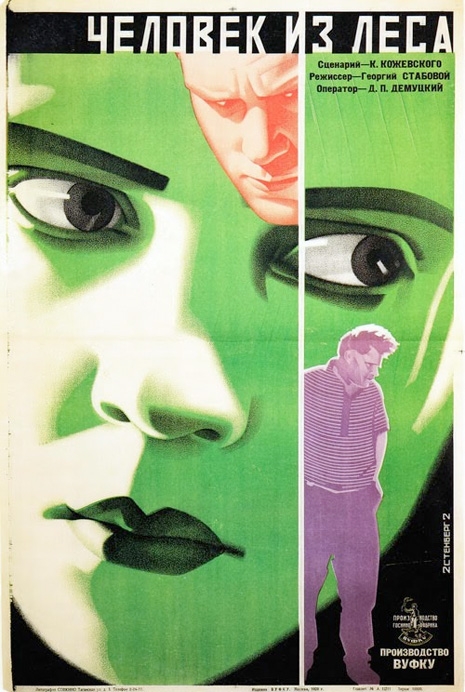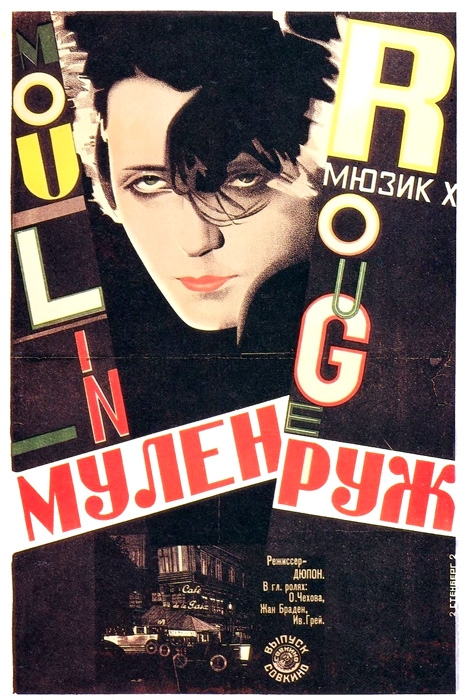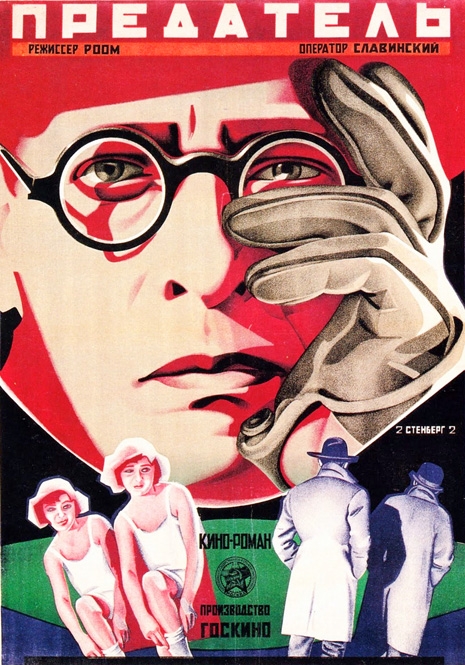
“Of all arts, for us cinema is the most important.”—Lenin, 1919
An exhibition of Soviet silent-era film posters now underway at London’s Gallery for Russian Arts and Design features, among many treasures, a fair few of the important works of the design team of brothers Vladimir and Georgii Stenberg. Far from household names, it’s true, but their place in art history is difficult to deny. Their success was somewhat serendipitous—it happened that their Dada-inspired method of found image manipulation dovetailed perfectly with the conceits and priorities of the Constructivist movement that was dominating Soviet graphics of their time. They enjoyed a nearly decade-long run of superb work that ended only with Georgii’s untimely death in a 1933 traffic accident. I quote at length here from curator Christopher Mount’s essay in the exhibition catalog of their 1997 MoMA retrospective:
The 1920s and early 1930s were a revolutionary period for the graphic arts throughout Europe. A drastic change took place in the way graphic designers worked that was a direct consequence of experimentation in both the fine and the applied arts. Not only did the formal vocabulary of graphic design change, but also the designer’s perception of self. The concept of the designer as “constructor”—or, as the Dadaist Raoul Hausmann preferred, “monteur” (mechanic or engineer)—marked a paradigmatic shift within the field, from an essentially illustrative approach to one of assemblage and nonlinear narrativity. This new idea of assembling preexisting images, primarily photographs, into something new freed design from its previous dependence on realism. The subsequent use of collage—a defining element of modern graphic design—enabled the graphic arts to become increasingly nonobjective in character.
In Russia, these new artist-engineers were attracted to the functional arts by political ideology. The avant-gardists’ rejection of the fine arts, deemed useless in a new Communist society, in favor of “art for use” in the service of the state, was key in the evolution of the poster. Advertising was now a morally superior occupation with ramifications for the new society; as such, it began to attract those outside the usual illustrative or painterly backgrounds—sculptors, architects, photographers—who brought new ideas and techniques to the field.
Vladimir and Georgii Stenberg were prominent members of this group, which was centered in Moscow and active throughout the 1920s and early 1930s. The Stenberg brothers produced a large body of work in a multiplicity of mediums, initially achieving renown as Constructivist sculptors and later working as successful theatrical designers, architects, and draftsmen; in addition, they completed design commissions that ranged from railway cars to women’s shoes. Their most significant accomplishment, however, was in the field of graphic design, specifically, the advertising posters they created for the newly burgeoning cinema in Soviet Russia.
These works merged two of the most important agitational tools available to the new Communist regime: cinema and the graphic arts. Both were endorsed by the state, and flourished in the first fifteen years of Bolshevik rule. In a country where illiteracy was endemic, film played a critical role in the conversion of the masses to the new social order. Graphic design, particularly as applied in the political placard, was a highly useful instrument for agitation, as it was both direct and economical. The symbiotic relationship of the cinema and the graphic arts would result in a revolutionary new art form: the film poster.





D.C. indie rock caught this wave.



“Kino/Film. Soviet Posters of the Silent Screen” runs at GRAD through March 29, 2014. Posters shown here are not intended to represent the content of that exhibit. Installation views are online at GRAD’s web site.